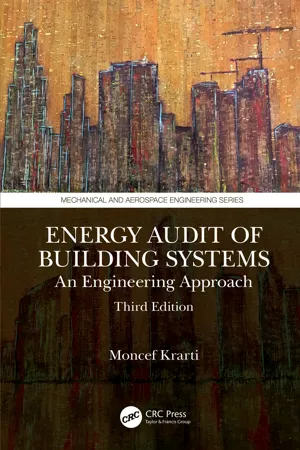
- 636 pages
- English
- ePUB (mobile friendly)
- Available on iOS & Android
About this book
Updated to include recent advances, this third edition presents strategies and analysis methods for conserving energy and reducing operating costs in residential and commercial buildings.
The book explores the latest approaches to measuring and improving energy consumption levels, with calculation examples and Case Studies. It covers field testing, energy simulation, and retrofit analysis of existing buildings. It examines subsystems—such as lighting, heating, and cooling—and techniques needed for accurately evaluating them.
Auditors, managers, and students of energy systems will find this book to be an invaluable resource for their work.
- Explores state-of-the-art techniques and technologies for reducing energy combustion in buildings.
- Presents the latest energy efficiency strategies and established methods for energy estimation.
- Provides calculation examples that outline the application of the methods described.
- Examines the major building subsystems: lighting, heating, and air-conditioning.
- Addresses large-scale retrofit analysis approaches for existing building stocks.
- Introduces the concept of energy productivity to account for the multiple benefits of energy efficiency for buildings.
- Includes Case Studies to give readers a realistic look at energy audits.
Moncef Krarti has vast experience in designing, testing, and assessing innovative energy efficiency and renewable energy technologies applied to buildings. He graduated from the University of Colorado with both MS and PhD in Civil Engineering. Prof. Krarti directed several projects in designing energy-efficient buildings with integrated renewable energy systems. He has published over 3000 technical journals and handbook chapters in various fields related to energy efficiency, distribution generation, and demand-side management for the built environment. Moreover, he has published several books on building energy-efficient systems. Prof. Krarti is Fellow member to the American Society for Mechanical Engineers (ASME), the largest international professional society. He is the founding editor of the ASME Journal of Sustainable Buildings & Cities Equipment and Systems. Prof. Krarti has taught several different courses related to building energy systems for over 20 years in the United States and abroad. As a professor at the University of Colorado, Prof. Krarti has been managing the research activities of an energy management center at the school with an emphasis on testing and evaluating the performance of mechanical and electrical systems for residential and commercial buildings. He has also helped the development of similar energy efficiency centers in other countries, including Brazil, Mexico, and Tunisia. In addition, Prof. Krarti has extensive experience in promoting building energy technologies and policies overseas, including the establishment of energy research centers, the development of building energy codes, and the delivery of energy training programs in several countries.
Frequently asked questions
- Essential is ideal for learners and professionals who enjoy exploring a wide range of subjects. Access the Essential Library with 800,000+ trusted titles and best-sellers across business, personal growth, and the humanities. Includes unlimited reading time and Standard Read Aloud voice.
- Complete: Perfect for advanced learners and researchers needing full, unrestricted access. Unlock 1.4M+ books across hundreds of subjects, including academic and specialized titles. The Complete Plan also includes advanced features like Premium Read Aloud and Research Assistant.
Please note we cannot support devices running on iOS 13 and Android 7 or earlier. Learn more about using the app.
Information
1 Introduction to Energy Audit
1.1 INTRODUCTION
1.2 TYPES OF ENERGY AUDITS
1.2.1 WALK-THROUGH AUDIT
1.2.2 UTILITY COST ANALYSIS
- To check the utility charges and ensure that no mistakes were made in calculating the monthly bills. Indeed, the utility rate structures for commercial and industrial facilities can be quite complex with ratchet charges and power factor penalties.
- To determine the most dominant charges in the utility bills. For instance, peak demand charges can be a significant portion of the utility bill, especially when ratchet rates are applied. Peak shaving measures can then be recommended to reduce these demand charges.
- To identify whether the facility can benefit from using other utility rate structures to purchase cheaper fuel and reduce its operating costs. This analysis can provide a significant reduction in the utility bills especially with implementation of electrical deregulation and the advent of real-time pricing (RTP) rate structures.
1.2.3 STANDARD ENERGY AUDIT
Table of contents
- Cover
- Half Title
- Title Page
- Copyright Page
- Contents
- Preface
- Author Biography
- 1 Introduction to Energy Audit
- 2 Energy Sources and Utility Rate Structures
- 3 Economic Analysis
- 4 Energy Analysis Tools
- 5 Electrical Systems
- 6 Building Envelope
- 7 Secondary HVAC Systems
- 8 Primary Heating and Cooling Systems
- 9 Distributed Energy Systems
- 10 Energy Management Control Systems
- 11 Smart Building Energy Systems
- xiii12 Water Management
- 13 Large-Scale Retrofit Analysis
- 14 Energy Productivity Analysis
- 15 Methods for Estimating Energy Savings
- 16 Audit Reports
- Appendix A
- Appendix B
- References
- Index